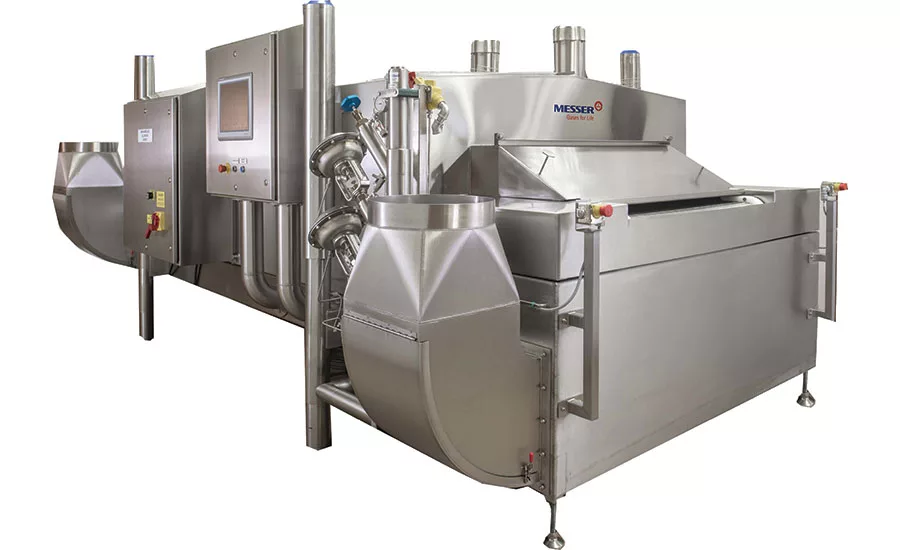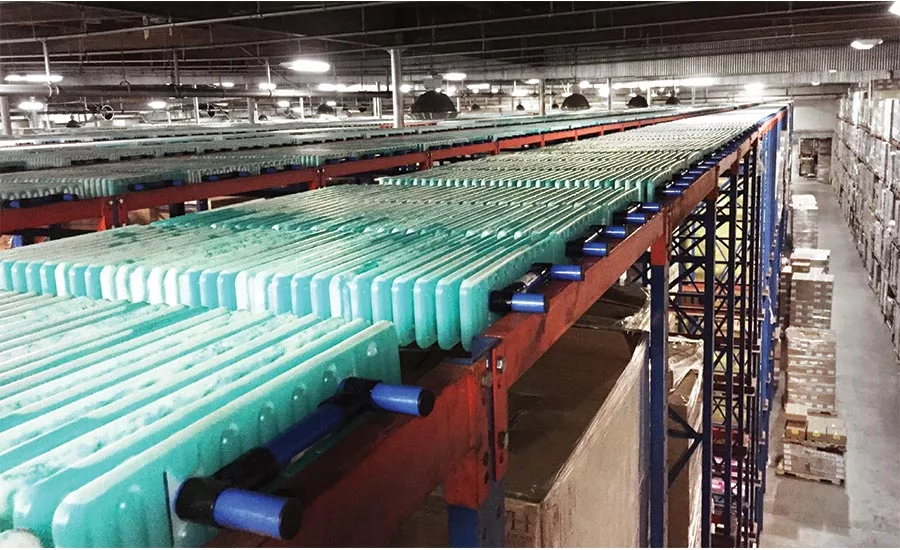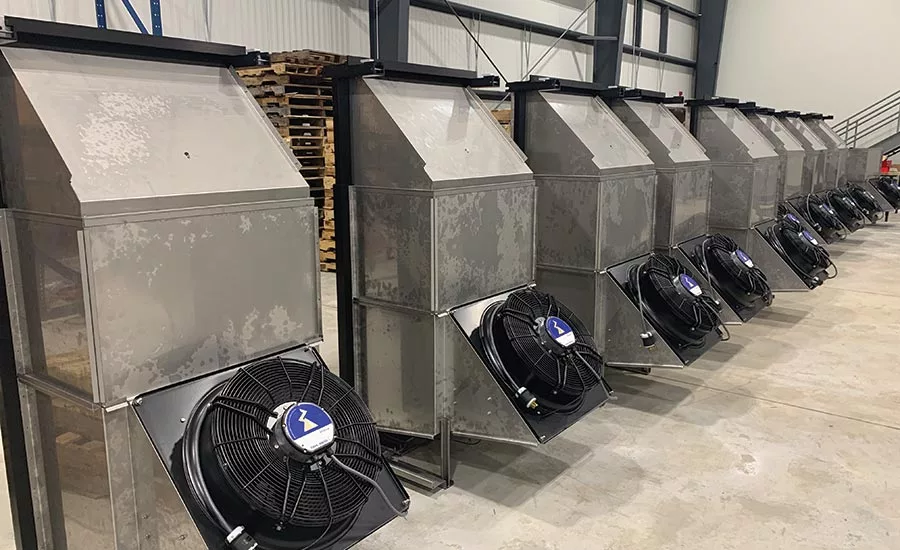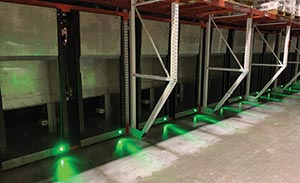Tech Update
Technologies help processors find best temperature for quality, efficiency

Messer’s new freezer for hot products—cooked, marinated chicken wings, for example—seals in moisture while preventing ice particle buildup.
Photo courtesy of Messer

Cells containing materials that absorb heat and rain down cold over food pallets fit right on top of the racking system.
Photo courtesy of Viking Cold Solutions

Tippman Innovation has taken its QuickFreeze In-Rack freezing system modular. QFM uses individual cooling units for each pallet position.
Photo courtesy of Tippmann Innovation

Green lights show that the modular units are running when pallets are in place.
Photo courtesy of Tippmann Innovation
When we looked around for what’s new and exciting with freezing and chilling equipment, three companies offered examples that stood out. They’re using interesting methods to keep refrigerated and frozen foods at just the right temperature.
- Messer has a freezer for a specific type of challenging foods: hot products such as cooked, marinated chicken.
- Viking Cold Solutions’ thermal energy storage technology is taking off because of utility incentives, energy efficiency goals and simple word of mouth as more processors and cold storage providers learn about the solution.
- Tippmann Engineering made its QuickFreeze In-Rack freezing system even better: The units are now modular so you can run the ones with pallets placed in front of them, while the other units at open rack spots turn off to save energy.
Read on to learn more about all three and get tips on ensuring that your cold and frozen food equipment helps you meet your benchmarks for safety, quality and efficiency.
Messer helps with hot product freezing
A new hot products freezer from Messer uses a high-velocity flow of cryogen for high heat transfer to help seal in moisture for cooked products, such as marinated chicken wings, breasts and fillets. It can remove the ice or snow particles that naturally form as steam flashes from hot or moist cooked foods.
The company debuted the freezer last month at the International Production and Processing Expo, along with a precision cryogenic control system for mixer chilling.
The tunnel freezer combines cryogenic and crossflow technologies to reduce dehydration losses by up to five times compared with mechanical methods and up to three times over conventional cryogenic freezers.
The advanced mixer chilling control system ensures the cryogen is matched to each batch and flows to each bottom injector for consistent temperatures across every batch, eliminating operator guesswork.
Q&A: How to make sure your equipment is right for your needs
Chris Ebeling, executive vice president, Messer North America Inc., shares insights on how to ensure your temperature control is helping you meet safety and quality standards.

FE: How does Messer help keep food safe and high quality when it comes to freezing equipment?
Ebeling: Temperature control throughout a food manufacturing process is critical for food safety and quality. Our technical teams specifically engineer freezing and chilling equipment to remove the proper amount of heat from the food product based on a customer’s process. Meeting critical time and temperature requirements for food safety is equally as important as designing equipment with hygienic features for ease of cleaning and minimizing risk in the food contact zone. We take critical steps to ensure our equipment provides both the performance and hygienic design our customers expect. With respect to quality, it is widely understood that freezing quickly with cryogenic liquids (liquid nitrogen or carbon dioxide) will lock in moisture and improve quality and yield over slower mechanical methods of temperature control.
FE: What regulations or standards must a food processing facility meet when it comes to the cold food chain?
Ebeling: In FSMA, the FDA mandated HACCP prevention procedures for such foods as juices, seafood and USDA-regulated meat and poultry. In 2016, new FSMA requirements went into effect for other food processors and suppliers known as Hazard Analysis and Risk-based Preventative Controls (HARPC). Production, packaging, transportation, handling and storage of food ingredients—including food-contact gases—must be fully documented under HARPC. The new FDA-mandated rules also encompass management oversight, including monitoring, corrective action and verification.
It should be noted that the Compressed Gas Association publishes a guideline (F3) for qualifying food and beverage gas suppliers. Major suppliers certify their production facilities to Global Food Safety Initiative (GFSI) benchmarked schemes. Some also provide quality assurance testing, in addition to HARPC and required documentation of food safety audits. Hygienic design of equipment and training can also play a valuable role in reducing risks.
FE: How does your company help ensure these standards/regulations are met for customers?
Ebeling: We understand that our freezing and chilling equipment may only be one step in the overall process of a food product. We ensure our technologies have the precision and control for our customers to effectively manage the appropriate temperature control to ensure safe products and maximize quality. This can range from a chilling step to remove heat from fresh products, fully freezing products or delivering a specific gas mixture prior to packaging to preserve freshness and extend shelf life.
FE: What new technology exists in the cold food environment?
Ebeling: Mixer and blender chilling technologies have gone largely unchanged for decades. We’ve taken this proven concept of injecting cryogen from the bottom of a mixer or blender and dramatically enhanced both the performance and food safety qualities of the technology. Messer’s patented chilling nozzle is specifically designed to prevent fouling, which helps ensure batch-to-batch chilling consistency. The same attributes that eliminate food particle entrapment also make it a perfect solution for chilling traditionally challenging products, such as wet poultry or sauces.
FE: What emerging freezing technologies should processors be aware of?
Ebeling: As a leader in cryogenic freezing and chilling technologies, Messer is continually working with customers to develop new and innovative solutions to improve their processes. As an example, Messer developed a freezing solution for individually quick-frozen (IQF) products that is unmatched in performance compared with alternative solutions. Combining a patented wave agitation motion with state-of-the-art impingement airflow, our freezing technology yields higher IQF quality at better efficiencies (i.e., lower cost) than ever before. In addition to improved IQF quality, customers now have the flexibility for higher production rates in the same amount of space, better efficiencies at matched production rates, or in some cases, a reduction in floor space required to freeze the same amount of product.
FE: What steps should cold food processing companies take to ensure quality and safe product?
Ebeling: Two very important factors to consider are having the proper technology for the product specifications required and a partnership with the right technical resources to optimize your process. There are many ways to achieve temperature control—finding the right equipment solution then working to optimize the process is the trick.
Thermal energy storage 101: Save your kWhs
The kilowatt has greater value than ever.
That’s what Collin Coker, vice president of sales and marketing for Viking Cold Solutions, wants cold and frozen food processors to know. Some of the biggest energy users on the market can wring out more value with thermal energy storage, he says.
“This is a challenge and an opportunity that owners and operators can take advantage of,” he explains in a webinar for the International Foodservice Distributors Association.
First he fills us in on the basics of the technology from his company that is rapidly expanding as processors and storage facilities look for help with rising energy costs, power outage protection and sustainability goals:
- Picture a lunch box gel pack. Cells are mounted on your pallet racking system. They contain phase change material that stores and releases energy as the substance transitions between solid and liquid.
- Think of thermal energy storage as a thermal battery. A standard battery stores energy as electrons; this system stores cold in a thermal energy cell. So basically it stores some of your refrigeration output.
- The cells do their work at the right times of day. By flywheeling—shutting down compressors at peak demand times—you get more compressor run time during cooler hours of the day when charges are lower. Lower ambient temperatures help compressors run a maximum designed efficiency, and heat is removed at the right time of day, using fewer kWh.
- It works with any kind of refrigerant, controls or racking. Processors of all sizes, handling all types of foods at varied low temperatures use thermal energy systems in their storage area. The same thing goes for large distribution centers and even grocery store walk-in freezers. Cells often are installed on top of racking. At a Dreyer’s Ice Cream facility for Nestlé with a two-pallet position racking system and a lower roof, the company creatively installed the cells in the ceiling.
Some of the benefits:
- Environmentally friendly: It requires no electricity to operate, a “passive” technology.
- Zero maintenance: “They (the cells) sit up there. They do their thing. They act as a very sophisticated heat sink. There’s no mechanical interface or requirements,” Coker says.
- Efficient: When heat enters the space, the food, floor, racking system, etc. absorb it. But the cells are 300 times more efficient at absorbing that heat than food.
- 50% more stable temperatures: The permanent mass constantly rains down cold over the food, helps keep stable temperatures at idle refrigeration times and prevents microthawing that harms food quality.
- Get help—or even get paid—by utilities: Utility-sponsored incentive programs are robust. Energy providers may pay you to shut down or shed load at certain parts of the day.
- Cost avoidance: You save for each kWh you don’t spend and for operating during lower demand times.
- Backup resiliency: The additional thermal mass provides three times longer temperature stability if the power goes out.
“It can make a huge difference in how that freezer operates,” Coker says.
The system’s intelligence controls are its primary value proposition, he explained. With the information they provide, companies can reduce consumption at peak demand or high time-of-use pricing periods.
“It is a kWh reduction technology, as well as a demand management strategy.”
How one processor saved
A 90,000-sq.-ft. facility in Northern California with two rooms, including one open to ambient air, is able to flywheel for 13 hours a day, six days a week with thermal energy storage. The overall campus lowered net consumption (kWh) by 43% with its installation.
Coker encourages you to think more broadly about energy and how you purchase it.
“This technology enables you to think differently on how you purchase. You’re no longer in a position to just be a price taker.”
Freeze each pallet on its own schedule
Tippmann Engineering is taking its own freezing technology to a new level. The company’s QuickFreeze In-Rack freezing system, around since about 2008, works differently than blast freezers by pulling cold air through spaces in pallets to freeze the food solid more quickly—down into the middle of the stack.
Now Tippmann is back with the new generation that’s modular, called QFM. Each pallet position gets its own cooling unit with an individual fan and plenum, and the units turn off automatically when no pallet is in place, saving energy.
 A green light tells you a unit is running, and a red light shines when it’s off. The unit telescopes up and down to fit a wide range of pallets. Putting a warm pallet next to a partially frozen one has no impact on the freezing time, explains Bob Tippmann, president and CEO of Tippmann Engineering.
A green light tells you a unit is running, and a red light shines when it’s off. The unit telescopes up and down to fit a wide range of pallets. Putting a warm pallet next to a partially frozen one has no impact on the freezing time, explains Bob Tippmann, president and CEO of Tippmann Engineering.
Plus, you can bring in extras during high-demand periods or roll them onto a truck to move them to a different facility if your production picks up there. That could help the produce industry, for example, as it follows the harvest north as crops ripen, Chairman Dan Tippmann says.
The company expects demand to shift to the modular version because of the advances it offers, including:
- Remote control for each unit from anywhere in the world
- Accountability and traceability at the per pallet level
- Unique profiles per SKU for each unit
- Ability to easily test freezing time adjustments
- Installation time as fast as 10 minutes
“It’s monumentally more sophisticated and is more aligned with all the food safety initiatives,” Dan Tippmann says.
Because QFM freezes so much faster, facilities have the flexibility to shut down units during peak energy use times.
With blast freezing, Bob Tippmann says the big black hole of information is knowing what’s going on inside the pallet. Because air follows the path with the least resistance, a lot of air moves around the pallets with blast freezing, and you hope that enough is getting in the middle to freeze the food in a reasonable time, he says. QFM gives the air only one path: through the spaces in the pallets. That cuts freezing time, and the faster you freeze a product, the better for quality.
Dan Tippmann says it can be challenging to get companies to divorce themselves from freezing in a batch system and move toward a continuous approach.
QFM offers a way for storage facilities without blast freezing capability to dip their toe in for a customer, then expand easily if that business picks up, he says.
Another plus: The company soon will have hundreds of units on hand for immediate shipment.
For more information:
Messer, www.messergroup.com
Tippmann Engineering, www.quickfreeze.com
Viking Cold Solutions, www.vikingcold.com
Looking for a reprint of this article?
From high-res PDFs to custom plaques, order your copy today!








